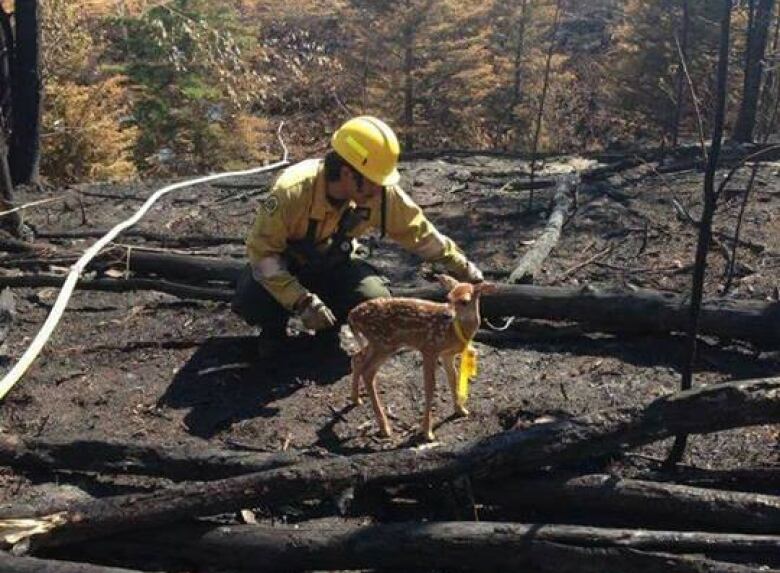Wildfire destroyed 30% of Waterton Lakes National Park, Alberta MP says, as rain provides some relief
Foothills MP says 'devastating' fire also destroyed 70% of forested area in park

The Watertonarea of southwestern Alberta has been hit hard by the ongoing Kenow wildfire, a member of Parliament said.
"The damage to Waterton is devastating," Foothills MP John Barlow said in a Facebook live video Wednesday.
"Hard to fathom the damage until you see it."
He says 30 per cent of Waterton Lakes National Park has been severely damaged, 70 per cent of the forested area has been lost and five homes outside of the park destroyed.
Thereis some relief in sight though.
Wet, cool weather Wednesday night provided some relief to crews battling the wildfire in southwestern Alberta which crosses over into B.C.
Parks Canada said Thursday about six millimetres of rain fell overnight on the Kenowwildfire, which has not grown beyond an estimated 360 square kilometres.
But the agency cautioned the situation remains serious and it may once again become intense despite the rain. Some 500 people have been subject to evacuation orders in the area.
- Albertansallowed to view properties affected by wildfire
- Water bombers back fighting 'Goliath of a fire'
TheKenowfire spread across the B.C.-Alberta boundary intoWatertonlate last week and the townsite was evacuated.
As firefighters worked to keep theKenowfire from spreading into theWatertontownsite on Monday night, a grass fire ignited near the gates at the northern portion of the park.
That fire spread through grassland outside the park's boundaries, destroying some properties and prompting the evacuation of parts of Cardston County, the Municipal District of Pincher Creek and the Blood reserve, a First Nations community southwest of Lethbridge.
Blood reserve, CardstonCounty, portions of M.D. of Pincher Creekevacuation orders lifted
The evacuation orders at the Blood reserve, Cardston County and portions of the M.D. of Pincher Creek have been lifted, but all others remained in effect Thursday.
Parks Canada said it's doing a detailed assessment of the damage and people should not return to the townsite yet.
"In the coming weeks, Parks Canada will inform the public once it has determined whether the entry of community and business owners within the park is safe," it said.
"The high intensity of the fire has severely impacted the landscape within the park. As a result, many areas will remain unsafe."
Oil and gas companies operating nearby have been taking precautions.
The Alberta Energy Regulator said as of Wednesday, Questfire Energy had shut down 10 natural gas wells, but the facility was not in danger.
It added that Shell Canada has shut in 24 wells and associated pipelines and has plans in place in the event it needs to shut itsWatertonsour gas plant southwest of Pincher Creek.
Park wildlife well adapted to survive fire
An Alberta wildlife official said the animals in and around Waterton Lakes National Park are well adapted to survive the flames.
MattBesko, who is director of wildlife policy at Alberta Environment and Parks, said wildlife left in the park have evolved to be able to deal with natural wildfires.
Some individual animals may become trapped and die.
"But for the most part, species are fairly mobile," he said. "Larger mammals will run, birds will fly."
Birds probably fared well because the fire did not sweep through during nesting season and the young would have fledged by now. Amphibians may have been able to protect themselves by burrowing under the dirt.
But some species such as squirrels and porcupines are more vulnerable because they can't run as fast.

The fire will transform the landscape in a way that will be beneficial to many animals in the long term, Besko said.
Some will have fresh leaves to munch on before too long.
"Many of our ungulates like deer, moose, elk, respond very favourably to recent fire activities because it does promote nutrient cycling as well as a flourish of new growth," he said.
Some animals, such as woodland caribou a species that lives farther north in Alberta need large tracts of uninterrupted old-growth habitat, so fires are a negative.
But Besko said it's rare that a naturally occurring fire would root out any particular species from an area.
With files from The Canadian Press












_(720p).jpg)


 OFFICIAL HD MUSIC VIDEO.jpg)
.jpg)



























































































